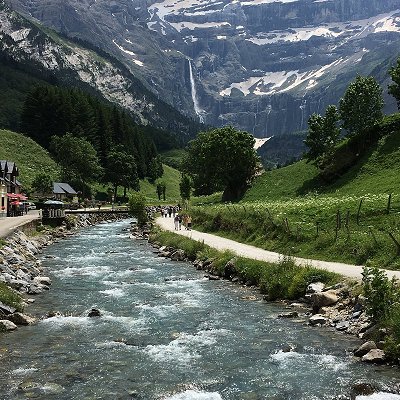
Like us on Facebook
PLACE NAMES


 
|
|
Gavarnie-Gèdre
|

|
|
Gavarnie-Gèdre is a commune in the department of Hautes-Pyrénées, southwestern France. The municipality was established on 1 January 2016 by merger of the former communes of Gavarnie and Gèdre.
The place is famed primarily for the Cirque de Gavarnie, which is a glacial valley. The southern border is on the mountains, with Aragon, Spain. It was described by Victor Hugo as "the Colosseum of nature" due to its enormous size and horseshoe shape resembling an ancient amphitheatre. The cirque was inscribed on the UNESCO World Heritage List in 1997 as part of the Pyrénées - Mont Perdu World Heritage Site.
The cirque is 800 m wide (on the deepest point) and about 3,000 m wide at the top. The rock walls that surround it are up to 1,500 metres (4,900 ft) above the floor of the Cirque.
During the warmer seasons of spring, summer and fall, there are a number of large meltwater falls that spill into the cirque. The largest of these is Gavarnie Falls, the second-highest waterfall in Europe. It descends some 422 metres (1,385 ft) over a series of steps before reaching the floor of the cirque.
There are also several passes and clefts between the peaks that form the rim of the Cirque. The largest is La Brèche de Roland, at 2,800 metres (9,200 ft) above sea level. According to legend, its sheer walls were cut into the mountain by the sword of the hero Roland, nephew to Charlemagne.
The cirque, and many others like it in the Pyrenees, was formed by the process of glacial erosion. The Cirque de Gavarnie's uniquely immense size was likely caused by repeated cycles of glacial scraping over millions of years.
A number of rare plants and animals live on the peaks at the upper rim of the Cirque de Gavarnie, protected on both the French and the Spanish sides by national parks. Martagon lilies grow in the pine forests. Saxifraga and other tiny alpine flowers cling to the rock faces. Chamois, a type of mammal similar to goats or antelope, live among the crags.
In the village of Gavarnie is a small church. The church, built around the 12th Century, lies on the Camino route. The church contains a cabinet which claims to hold the skulls of a number of the Knights Templar who died whilst traveling to Compostela. The church was an influential factor in the listing of the village of Gavarnie as a UNESCO World Heritage Site. The village is visited by those who ski and by HCPT Pilgrimages to Lourdes..
 Feel free to Email me any additions or corrections Feel free to Email me any additions or corrections
LINKS AVAILABLE TO YOUR SITE
| | |





